中国市场营销起源和发展过程
市场营销观念的演变历程
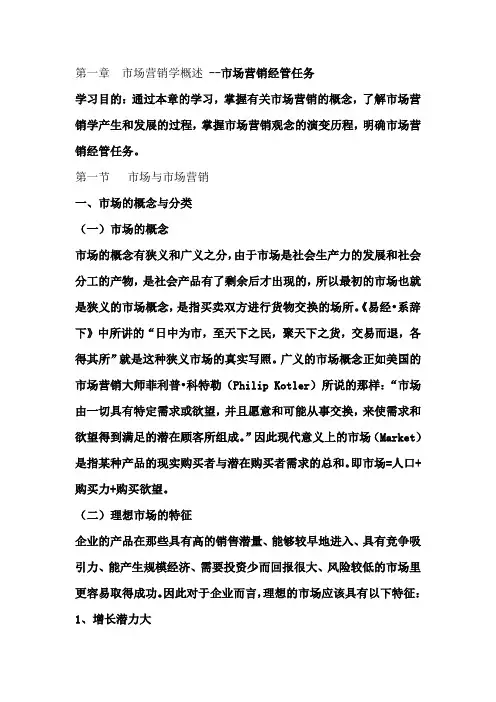
第一章市场营销学概述 --市场营销经管任务学习目的:通过本章的学习,掌握有关市场营销的概念,了解市场营销学产生和发展的过程,掌握市场营销观念的演变历程,明确市场营销经管任务。
第一节市场与市场营销一、市场的概念与分类(一)市场的概念市场的概念有狭义和广义之分,由于市场是社会生产力的发展和社会分工的产物,是社会产品有了剩余后才出现的,所以最初的市场也就是狭义的市场概念,是指买卖双方进行货物交换的场所。
《易经•系辞下》中所讲的“日中为市,至天下之民,聚天下之货,交易而退,各得其所”就是这种狭义市场的真实写照。
广义的市场概念正如美国的市场营销大师菲利普•科特勒(Philip Kotler)所说的那样:“市场由一切具有特定需求或欲望,并且愿意和可能从事交换,来使需求和欲望得到满足的潜在顾客所组成。
”因此现代意义上的市场(Market)是指某种产品的现实购买者与潜在购买者需求的总和。
即市场=人口+购买力+购买欲望。
(二)理想市场的特征企业的产品在那些具有高的销售潜量、能够较早地进入、具有竞争吸引力、能产生规模经济、需要投资少而回报很大、风险较低的市场里更容易取得成功。
因此对于企业而言,理想的市场应该具有以下特征:1、增长潜力大市场潜力即市场潜量,是未来一定时期内,在某种特定市场上购买某种商品可能达到的最大货币支付能力。
它是按照市场的销售额和增长率来衡量的,是识别市场新机会的关键因素。
市场增长潜力的大小直接影响企业产品的价格和边际利润,从而影响企业的经济效益。
2、赢利空间大市场的顾客数量及购买力,要足以使企业有利可图,能够实现一定的规模效益,同时能够适应企业今后发展扩大的需要,使企业保持长期的经济效益。
3、竞争能力强虽然市场正在增长,进入者也不多,存在规模经济,但如果处于敌对性的竞争环境中,使企业的产品无法获得高份额的市场地位,这个市场也不是一个理想的市场。
在美国成熟的汽车市场上,20世纪80年代美国国内的汽车厂商很容易受到质量更高且更省油的日本和欧洲汽车的攻击。
双十一营销背景高清
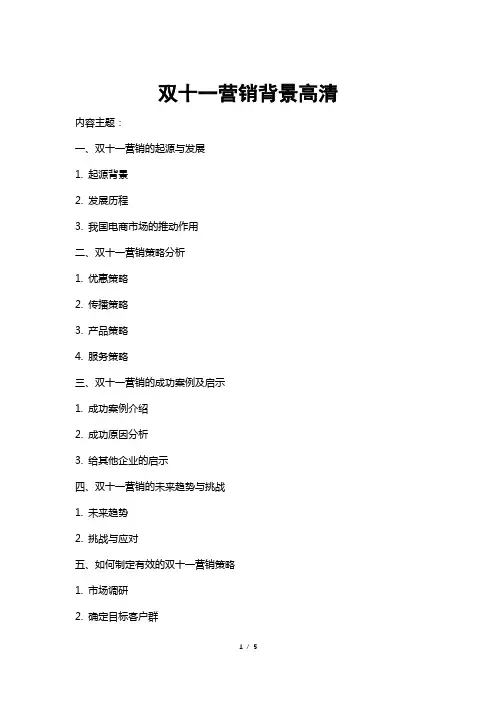
双十一营销背景高清内容主题:一、双十一营销的起源与发展1. 起源背景2. 发展历程3. 我国电商市场的推动作用二、双十一营销策略分析1. 优惠策略2. 传播策略3. 产品策略4. 服务策略三、双十一营销的成功案例及启示1. 成功案例介绍2. 成功原因分析3. 给其他企业的启示四、双十一营销的未来趋势与挑战1. 未来趋势2. 挑战与应对五、如何制定有效的双十一营销策略1. 市场调研2. 确定目标客户群3. 制定具体的营销策略4. 营销实施与监控5. 营销效果评估与优化一、双十一营销的起源与发展1. 起源背景双十一,原本是我国的传统节日“光棍节”,因为日期为11月11日,形似四根孤立的光棍,故得此名。
2009年,阿里巴巴集团将其打造成了一场购物狂欢节,从此开启了双十一的电商营销时代。
2. 发展历程自2009年至今,双十一已经走过了10个年头。
在这10年间,双十一的交易额从最初的5000万元跃升至2018年的2135亿元,增长了近4000倍。
这一奇迹的背后,是我国电商市场的蓬勃发展以及消费者购物需求的持续升级。
3. 我国电商市场的推动作用双十一的成功,离不开我国电商市场的推动。
近年来,我国电商市场规模不断扩大,线上消费逐渐成为一种主流购物方式。
根据我国商务部数据显示,2018年我国网络零售市场规模达到9.08万亿元,同比增长23.9%。
在这样的市场背景下,双十一应运而生,成为电商企业争夺市场份额、提升品牌知名度的绝佳时机。
二、双十一营销策略分析1. 优惠策略双十一的核心吸引力在于其巨大的优惠力度。
各商家通过设置限时抢购、满减、优惠券、红包雨等多种形式的优惠活动,刺激消费者的购买欲望。
预售活动的推出,使得消费者可以提前锁定心仪的商品,进一步提高了双十一的购物热情。
2. 传播策略双十一的传播策略主要依赖于网络平台。
各大电商平台会提前进行广告投放,利用搜索引擎、社交媒体、短视频平台等多渠道进行宣传。
同时,邀请明星代言、网红直播、KOL种草等方式,扩大活动影响力,吸引更多消费者参与。
市场营销学(第五版)PPT全套课件
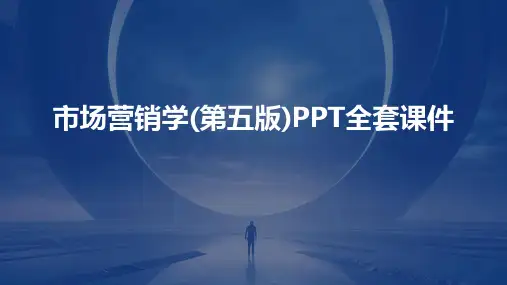
目录
• 市场营销概述 • 消费者行为分析 • 市场细分与目标市场选择 • 产品策略 • 价格策略 • 分销渠道策略 • 促销策略 • 市场营销管理过程
01
市场营销概述
市场营销的定义与重要性
定义
市场营销是通过创造、传播和交付价值,来管理客户关系的一系列过程。其目 的是为组织及其利益相关者创造、沟通和交付价值。
识别消费者需求和
行为
深入了解目标消费者的需求、偏 好、购买行为和决策过程,以发 现市场机会。
分析竞争态势
评估竞争对手的市场地位、产品 特点、营销策略等,以了解市场 竞争格局和潜在机会。
选择目标市场
01
确定市场细分
根据消费者需求、行为等特征, 将市场划分为不同的细分市场, 以便选择目标市场。
02
评估细分市场吸引 力
市场需求的变化对产品价格有 着直接的影响,需根据市场供 需情况灵活调整价格。
竞争状况
竞争对手的定价策略及市场地 位,对企业定价具有参考意义 。
法律法规
政府的价格政策、法规及国际 贸易规则等,也会对定价产生
影响。
定价方法与技巧
成本导向定价法
以成本为基础,加上预期利润来确定价格。
竞争导向定价法
参考竞争对手的价格来制定自己的价格策略 。
将多种产品组合在一起销售,以实现 整体利润最大化。
心理定价策略
利用消费者心理,采用高价定位、低 价定位等策略来影响消费者购买决策 。
06
分销渠道策略
分销渠道概述及类型
01
分销渠道定义:分销渠道是指商品从生产者流转到消费者 过程中所经过的各个环节连接起来形成的通道。
02
双十一营销历史背景析
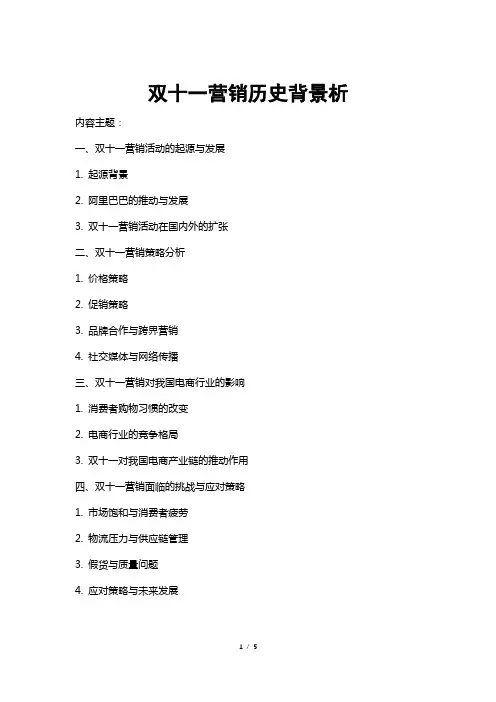
双十一营销历史背景析内容主题:一、双十一营销活动的起源与发展1. 起源背景2. 阿里巴巴的推动与发展3. 双十一营销活动在国内外的扩张二、双十一营销策略分析1. 价格策略2. 促销策略3. 品牌合作与跨界营销4. 社交媒体与网络传播三、双十一营销对我国电商行业的影响1. 消费者购物习惯的改变2. 电商行业的竞争格局3. 双十一对我国电商产业链的推动作用四、双十一营销面临的挑战与应对策略1. 市场饱和与消费者疲劳2. 物流压力与供应链管理3. 假货与质量问题4. 应对策略与未来发展一、双十一营销活动的起源与发展1. 起源背景双十一,即每年的11月11日,最初是我国的“光棍节”。
2009年,阿里巴巴集团在这一天推出了“双十一”购物狂欢节活动,将其定为一场网络促销活动。
当时,我国电商行业正处于快速发展阶段,阿里巴巴希望通过这个活动,激发消费者的购物热情,推动电商市场的发展。
2. 阿里巴巴的推动与发展2009年首届双十一购物狂欢节,阿里巴巴旗下的淘宝、天猫等平台销售额达到了5000万元。
此后,阿里巴巴不断加大对双十一的投入,联合各大品牌商家进行促销,引入更多的营销手段,使得双十一逐渐成为我国电商行业的一大盛事。
3. 双十一营销活动在国内外的扩张随着双十一在我国的火爆,越来越多的国家和地区开始关注这一现象。
2014年,阿里巴巴将双十一推向全球,吸引了众多国际品牌参与。
如今,双十一已成为全球范围内最具影响力的购物狂欢节之一,不仅带动了我国电商行业的发展,也为全球电商市场注入了新的活力。
二、双十一营销策略分析1. 价格策略双十一的核心吸引力之一就是价格优惠。
在双十一期间,商家通常会推出极具竞争力的价格策略,包括直降、满减、优惠券等多种形式。
消费者可以在这一天享受到全年度最低的价格,从而激发他们的购物欲望。
2. 促销策略除了价格优惠,促销活动也是双十一营销的重要手段。
电商平台和商家会推出各种促销活动,如限时抢购、整点秒杀、抽奖等,以提高用户参与度和购买率。
市场营销营销的由来和发展
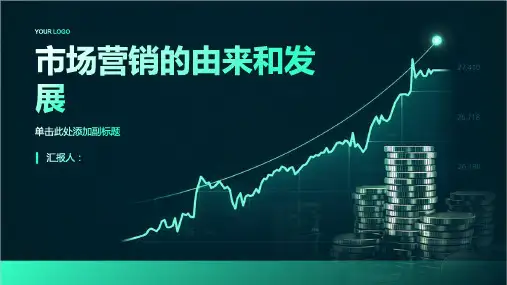
实践:早期的市场营销主要通过广告、推销、公 关等方式进行,如报纸、杂志、广播、电视等媒 体广告,以及销售人员的直接推销。
发展:随着科技的进步和市场环境的变化, 市场营销的方式和手段也在不断更新和发 展,如互联网营销、社交媒体营销、大数 据营销等。
影响:市场营销的起源和发展对现代企业的经营 和管理产生了深远的影响,成为企业经营成功的 重要因素之一。
1980-2000年:市场营销的创新阶段,出 现了关系营销、网络营销等概念
2000年至今:市场营销的数字化阶段, 出现了大数据营销、社交媒体营销等概念
互联网时代市场营销的变革
数据驱动营销:利用大数据 分析客户行为和需求,实现 精准营销
内容营销:通过创造有价值 的内容吸引和留住客户
社交媒体营销:利用社交媒 体平台进行品牌推广和产品 销售
体验营销:注重客户体验, 提供个性化、定制化的产品
和服务
绿色营销:关注环保和可持 续发展,倡导绿色消费
跨界营销:不同行业、品牌 之间的跨界合作,实现资源
共享和优势互补
市场营销理论的形成与演进
起源:19世纪末,美国学者提出市场营销的概念 发展:20世纪初,市场营销理论逐渐形成 演进:20世纪中叶,市场营销理论逐渐成熟 应用:20世纪末,市场营销理论在全球范围内得到广泛应用
社交营销:利用社交媒体平台进行 品牌传播和互动
体验营销:注重客户体验,提供个 性化、定制化的产品和服务
绿色营销:关注环保和可持续发展, 倡导绿色消费
跨界营销:与其他行业进行跨界合 作,实现资源共享和优势互补
单击添加标题
市场营销的发展 历程
市场营销的未来 展望
市场营销的起源
市场营销的理论 与实践
起源背景
营销学的产生与发展
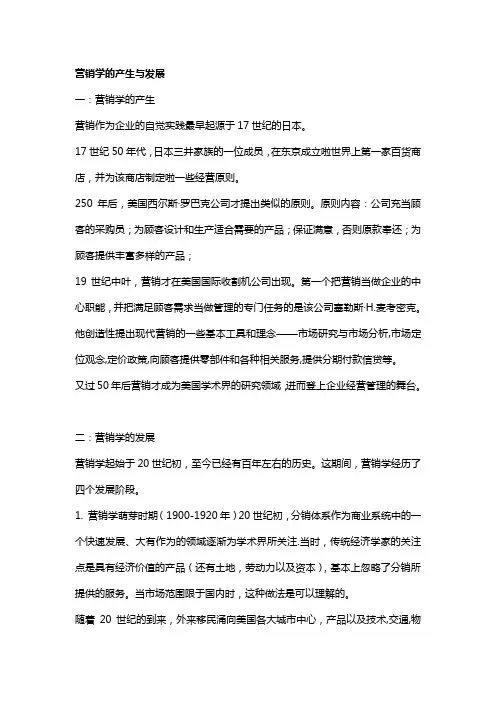
营销学的产生与发展一:营销学的产生营销作为企业的自觉实践最早起源于17世纪的日本。
17世纪50年代,日本三井家族的一位成员,在东京成立啦世界上第一家百货商店,并为该商店制定啦一些经营原则。
250年后,美国西尔斯·罗巴克公司才提出类似的原则。
原则内容:公司充当顾客的采购员;为顾客设计和生产适合需要的产品;保证满意,否则原款奉还;为顾客提供丰富多样的产品;19世纪中叶,营销才在美国国际收割机公司出现。
第一个把营销当做企业的中心职能,并把满足顾客需求当做管理的专门任务的是该公司塞勒斯·H.麦考密克。
他创造性提出现代营销的一些基本工具和理念——市场研究与市场分析,市场定位观念,定价政策,向顾客提供零部件和各种相关服务,提供分期付款信贷等。
又过50年后营销才成为美国学术界的研究领域,进而登上企业经营管理的舞台。
二:营销学的发展营销学起始于20世纪初,至今已经有百年左右的历史。
这期间,营销学经历了四个发展阶段。
1.营销学萌芽时期(1900-1920年)20世纪初,分销体系作为商业系统中的一个快速发展、大有作为的领域逐渐为学术界所关注.当时,传统经济学家的关注点是具有经济价值的产品(还有土地,劳动力以及资本),基本上忽略了分销所提供的服务。
当市场范围限于国内时,这种做法是可以理解的。
随着20世纪的到来,外来移民涌向美国各大城市中心,产品以及技术,交通,物流的进步等使得市场形势急剧变化,分销体系迅速发展和改进。
此时,确实需要经济学家出来研究并解释这些尚未融入到主流思想的要素。
在这种形势下,美国高校承担大学商科教学的教师开始注意到交换领域的定价,分销和广告问题的研究,开设一些新课程,譬如密歇根大学开设的“产业分销”,纽约大学开设的“商业制度”等。
这一时期后半段,经济学刊物对于处于萌芽状态的营销学给予了很多重要的支持和帮助,使其开始创立出概念上与众不同的方法,促进啦该领域知识的发展。
比如产品研究法,机构研究法和职能研究法就是在这一时期发展起来的。
市场营销学课本pdf
通过社交媒体平台展示品牌故 事,吸引用户关注和参与,同 时注重内容创意和互动性。
大数据与精准营销
运用大数据分析消费者行为和 需求,实现个性化推荐和精准 投放。
数字化营销挑战
如数据隐私保护、技术更新迅 速、消费者行为变化等,要求 企业不断适应并创新数字化营 销策略。
06 营销道德与法规
品牌与包装策略
塑造品牌形象,设计适当的包装,以增加产品附加值 和吸引力。
价格策略
定价目标与方法
根据企业目标、市场需求和竞争 状况,选择合适的定价目标和定 价方法。
价格策略类型
包括撇脂定价、渗透定价、满意 定价等,以实现市场份额和利润 的最大化。
价格调整策略
根据市场变化和竞争状况,适时 调整价格,以保持竞争优势和市 场份额。
营销道德概述与原则
营销道德的定义与内涵
营销道德是指在市场营销活动中,企业和 营销人员应遵循的道德规范和职业操守, 包括诚信、公平、责任、尊重等方面。
VS
营销道德的重要性
营销道德是企业长期发展的基石,能够提 高企业的社会形象和声誉,增强消费者对 企业的信任和忠诚度,促进企业的可持续 发展。
营销法规与政策解读
销售促进策略
采用各种促销手段,如 折扣、赠品、抽奖等, 激发消费者购买欲望。
公共关系策略
通过公关活动建立良好 的企业形象和产品形象, 提高品牌价值和市场份 额。
人员推销策略
通过销售人员与潜在消 费者进行面对面的交流 和推销,实现产品的销 售和推广。
04 品牌建设与管理
品牌的概念与价值
品牌定义
品牌是一种名称、术语、设计、符号或其他特征,用于区分一个卖家的产品或服务与其他卖家。
《市场营销学》PPT课件
包括对中间商的激励、控制和评价等。
促销组合
促销组合的概念 促销手段的选择 促销预算的制定 促销效果的评估
促销组合是指企业综合运用各种促销手段,包括广告、销售促 进、公共关系和人员推销等,以促进产品销售的策略。
需要考虑目标市场的特点、竞争状况和企业自身的资源等因素 。
可以采用量入为出法、销售百分比法、竞争对等法和目标任务 法等。
总结词
营销执行是将营销计划转化为实际营销行动的过程,要求企业具备强大的组织协 调和执行力。
详细描述
营销执行包括产品推广、渠道拓展、促销活动组织等具体工作。在这个过程中, 企业需要建立完善的销售网络和渠道体系,加强与经销商和终端消费者的沟通与 合作,以确保营销计划的顺利实施。
营销控制
总结词
营销控制是对企业营销活动进行监督和调整的过程,通过对营销绩效的评估和反馈,不断完善和优化营销策略。
详细描述
营销控制包括制定绩效评估标准、收集和分析数据、调整营销策略等步骤。企业需要建立完善的营销控制系统, 定期对营销活动进行评估和反馈,及时发现问题并采取措施进行调整和改进,以提高企业营销绩效和市场竞争力 。
06
CATALOGUE
营销理论的新发展
网络营销
1
2
3
定义
网络营销是一种利用互联网技术,通过数字化信 息和互动媒体渠道来进行的市场营销活动。
包括确定目标市场的需求和竞争状况、制定差异化策略和 传播策略等。
04
CATALOGUE
营销组合
产品组合
产品组合的概念
产品组合是指企业提供给市场的所有产品线和产品项目的组合或搭配 ,即经营范围和结构的决策。
产品组合的宽度
产品组合的宽度是指一个企业有多少产品线。
市场营销ppt课件
市场营销团队建设与管理
01
02
03
04
组建高效团队
选拔具备市场营销专业知 识和实践经验的人才,组 建高效、专业的市场营销 团队。
明确团队职责
明确团队成员的职责分工 ,确保各项工作得以顺利 进行。
建立沟通机制
建立有效的沟通机制,促 进团队成员之间的信息交 流与合作,提高工作效率 。
激励与考核
制定合理的激励与考核制 度,激发团队成员的工作 积极性和创造力,提高团 队整体绩效。
消费者购买行为分析
研究消费者的购买决策过程、购买频率、购买偏好等。
消费者需求特点
分析消费者对产品功能、品质、价格、服务等方面的需求特点。
市场竞争分析
01
02
03
竞争对手识别
确定主要竞争对手,包括 直接竞争对手和间接竞争 对手。
竞争策略分析
研究竞争对手的产品策略 、价格策略、渠道策略、 促销策略等。
策略提供依据。
A 确定市场营销目标
明确企业市场营销的长期和短期目 标,以及实现这些目标所需的策略
和行动计划。
B
C
D
执行营销计划
组织企业资源,实施营销计划,确保各项 营销活动得以顺利开展并取得预期效果。
制定营销计划
根据市场环境分析结果,制定具体的营销 计划,包括产品策略、价格策略、渠道策 略和促销策略等。
竞争优劣势评估
分析自身与竞争对手在市 场份额、品牌知名度、技 术实力等方面的优劣势。
市场趋势预测
行业发展趋势
分析所在行业的发展阶段、市 场规模、增长速度等趋势。
技术创新趋势
关注新技术、新工艺对市场的 影响,预测未来技术发展趋势 。
消费者需求变化趋势
市场营销ppt全套课件
价格策略类型及实施技巧
01
02
03
04
折扣定价策略
通过给予消费者一定的价格折 扣来吸引购买
心理定价策略
利用消费者心理来制定价格, 如尾数定价、整数定价等
地区定价策略
根据不同地区的市场需求和竞 争状况制定不同的价格
产品组合定价策略
将多种产品组合在一起销售, 以整体价格优势吸引消费者
价格调整与价格竞争应对
加强渠道管理
建立完善的渠道管理制度和流程,提高管理效率。
创新渠道模式
探索新的渠道模式,如线上线下融合、社交电商等,以适应市场变化 。
06
促销策略
促销类型及目标设定
降价促销
通过降低产品价格吸引消费者购买。
赠品促销
购买产品即赠送相关礼品或小样。
促销类型及目标设惠活动。
通过市场调研和数据分析,识别消费 者的真实需求和潜在需求。
消费者购买决策过程
消费者行为模式
研究消费者的购买习惯、品牌偏好、 消费观念等,以预测市场趋势和制定 营销策略。
了解消费者在购买过程中的心理和行 为变化,以及影响购买决策的因素。
竞争对手分析
01
02
03
竞争对手识别
通过市场调研和情报收集 ,识别主要的竞争对手和 潜在竞争对手。
传统媒体广告
利用电视、广播、报纸、杂志 等传统媒体进行广告投放,扩
大品牌知名度。
数字媒体营销
运用社交媒体、搜索引擎优化 (SEO)、电子邮件营销等数 字媒体手段,精准触达目标消 费者。
线下活动推广
举办新品发布会、赞助活动、 公关活动等线下活动,提升品 牌影响力。
口碑营销
通过消费者推荐、评论、评分 等方式,借助口碑力量传播品
- 1、下载文档前请自行甄别文档内容的完整性,平台不提供额外的编辑、内容补充、找答案等附加服务。
- 2、"仅部分预览"的文档,不可在线预览部分如存在完整性等问题,可反馈申请退款(可完整预览的文档不适用该条件!)。
- 3、如文档侵犯您的权益,请联系客服反馈,我们会尽快为您处理(人工客服工作时间:9:00-18:30)。
市场营销理论在中国的发展新中国建立之前,我国虽曾对市场营销学有过一些研究(当时称“销售学”),但也仅限于几所设有商科或管理专业的高等院校。
在1949~1978年间,除了台湾和港澳地区的学术界、企业界对这门学科已有广泛的研究和应用外,在整个中国内地,市场营销学的研究一度中断。
在这长达三十多年的时间里,国内学术界对国外市场营销学的发展情况知之甚少。
党的十一届三中全会以后,党中央提出了对外开放、对内搞活的总方针,从而为我国重新引进和研究市场营销学创造了有利的环境。
1978年,北京、上海、广州的部分学者和专家开始着手市场营销学的引进研究工作。
虽然当时还局限在很小的范围内,而且在名称上还称为“外国商业概论”或“销售学原理”,但毕竟在市场营销学的引进上迈出了第一步。
经过十几年的时间,我国对于市场营销学的研究、应用和发展已取得了可喜的成绩。
从整个发展过程来看,大致经历了以下几个阶段。
(一)引进时期(1978~1982年)在此期间,通过对国外市场营销学著作、杂志和国外学者讲课的内容进行翻译介绍,选派学者、专家到国外访问、考察、学习,邀请外国专家和学者来国内讲学等方式,系统介绍和引进了国外市场营销理论。
但是,当时该学科的研究还局限于部分大专院校和研究机构,从事该学科引进和研究工作的人数还很有限,对于西方市场营销理论的许多基本观点的认识也比较肤浅,大多数企业对于该学科还比较陌生。
然而,这一时期的努力毕竟为我国市场营销学的进一步发展打下了基础。
(二)传播时期(1983~1985年)经过前一时期的努力,全国各地从事市场营销学研究、教学的专家和学者开始意识到,要使市场营销学在中国得到进一步的应用和发展,必须成立各地的市场营销学研究团体,以便相互交流和切磋研究成果,并利用团体的力量扩大市场营销学的影响,推进市场营销学研究的进一步发展。
1984年1月,全国高等综合大学、财经院校市场学教学研究会成立。
在以后的几年时间里,全国各地各种类型的市场营销学研究团体如雨后春笋般纷纷成立。
各团体在做好学术研究和学术交流的同时,还做了大量的传播工作。
例如,广东市场营销学会定期出版了会刊《营销管理》,全国高等综合大学、财经院校市场学教学研究会在每届年会后都向会员印发了各种类型的简报。
各团体分别举办了各种类型的培训班、讲习班。
有些还通过当地电视台、广播电台举办了市场营销学的电视讲座和广播讲座。
通过这些活动,既推广、传播了市场营销学知识,又扩大了学术团体的影响。
在此期间,市场营销学在学校教学中也开始受到重视,有关市场营销学的著作、教材、论文在数量上和质量上都有很大的提高。
(三)应用时期(1986~1988年)1985年以后,我国经济体制改革的步伐进一步加快,市场环境的改善为企业应用现代市场营销原理指导经营管理实践提供了有利条件,但各地区、各行业的应用情况又不尽相同,具体表现为:(1)以生产经营指令性计划产品为主的企业应用得较少,以生产经营指导性计划产品或以市场调节为主的产品的企业应用得较多、较成功;(2)重工业、交通业、原材料工业等和以经营生产资料为主的行业所属的企业应用得较少,而轻工业、食品工业、纺织业、服装业等以生产经营消费品为主的行业所属的企业应用得较多、较成功;(3)经营自主权小、经营机制僵化的企业应用得较少,而经营自主权较大、经营机制灵活的企业应用得较多、较成功;(4)商品经济发展较快的地区(尤其是深圳、珠海等经济特区)的企业应用市场营销原理的自觉性较高,应用得也比较好。
在此期间,多数企业应用市场营销原理时,偏重于分销渠道、促销、市场细分和市场营销调研部分。
(四)扩展时期(1988~1994年)在此期间,无论是市场营销教学研究队伍,还是市场营销教学、研究和应用的内容,都有了极大的扩展。
全国各地的市场营销学学术团体,改变了过去只有学术界、教育界人士参加的状况,开始吸收企业界人士参加。
其研究重点也由过去的单纯教学研究,改为结合企业的市场营销实践进行研究。
全国高等综合大学、财经院校市场学教学研究会也于1987年8月更名为“中国高等院校市场学研究会”。
学者们已不满足于仅仅对市场营销一般原理的教学研究,而对其各分支学科的研究日益深入,并取得了一定的研究成果。
在此期间,市场营销理论的国际研讨活动进一步发展,这极大地开阔了学者们的眼界。
1992年春,邓小平南方讲话以后,学者们还对市场经济体制的市场营销管理,中国市场营销的现状与未来,跨世纪中国市场营销面临的挑战、机遇与对策等重大理论课题展开了研究,这也有力地扩展了市场营销学的研究领域。
(五)国际化时期(1995~至今)1995年6月,由中国人民大学、加拿大麦吉尔大学和康克迪亚大学联合举办的第五届市场营销与社会发展国际会议在北京召开。
中国高等院校市场学研究会等学术组织作为协办单位,为会议的召开作出了重要的贡献。
来自46个国家和地区的135名外国学者和142名国内学者出席了会议。
25名国内学者的论文被收入《第五届市场营销与社会发展国际会议论文集》(英文版),6名中国学者的论文荣获国际优秀论文奖。
从此,中国市场营销学者开始全方位、大团队地登上国际舞台,与国际学术界、企业界的合作进一步加强。
五、市场营销理论应用的发展第二次世界大战之后,市场营销学发生了根本性的变化,从传统市场营销学演变为现代市场营销学,市场营销学日益广泛应用于社会各领域,同时,从美国拓展到其他国家。
(一)市场营销学广泛应用于社会各领域市场营销观念和理论首先被引进生产领域,先是日用品公司,如小包装消费品公司,继而被引入耐用消费品公司,接着被引进工业设备公司,稍后被引入重工业公司诸如钢铁、化工公司。
其次,从生产领域引入服务业领域,先是被引入航空公司、银行,继而保险、证券金融公司。
后来,又被专业团体,诸如律师、会计师、医生和建筑师所运用。
由于资本主义国家一切成为商品,连其社会领域及政治领域也商品化,因而市场营销原理与方法亦应用于这些领域,如将市场营销方法应用于大学、医院、博物馆及政府政策的推行等社会领域中;又如法国政府应用市场营销原则与方法了解公众对政府废除死刑及扩大欧洲共同体的看法,根据公众不同的政见进行市场细分,然后采用广告宣传去影响或改变公众对政府政策的反对态度;再如西方国家政党及政治候选人应用市场营销方法对选民进行市场细分,对选民进行广告宣传,争取选民投票支持。
市场营销的应用还从国内扩展至国际市场。
与市场营销学应用范围的扩大相适应,市场营销学从基础市场营销学扩展为工业市场营销学、服务市场营销学、社会市场营销学、政治市场营销学及国际市场营销学。
(二)市场营销学在各国应用的发展20世纪初,市场营销学首创于美国,随后广泛应用于各个领域。
20世纪50年代市场营销学开始传播到其他西方国家。
日本于50年代初开始引进市场营销学,1953年日本东芝电气公司总经理石坂泰三赴美参观访问,回到日本的第一句话是:“我们要全面学习市场营销学”。
1955年日本生产力中心成立,1957年日本营销协会成立。
这两个组织对推动营销学的发展起了积极作用。
60年代,日本经济进入快速发展时期,市场营销原理和方法广泛应用于家用电器工业,市场营销观念被广泛接受。
60年代末70年代初,社会市场营销观念开始引起日本企业界的关注。
从70年代后期起,随着日本经济的迅猛发展及国际市场的迅速扩大,日本企业开始从以国外各个市场为着眼点的经营战略向全球营销战略转变。
20世纪50年代,市场营销学亦传播到法国,最初应用于英国在法国的食品分公司。
60年代开始应用于工业部门,继而扩展到社会服务部门。
1969年被引进法国国营铁路部门。
70年代初,市场营销学课程先后在法国各高等院校开设。
20世纪60年代后,市场营销学被引入原苏联及东欧国家。
中国则是自改革开放以后,才开始引进市场营销学的。
首先是通过对国外市场营销学书刊杂志及国外西方学者讲课内容进行翻译介绍。
其次,自1978年以来选派学者、专家、学生赴国外访问、学习、考察国外市场营销学开设课程状况及国外企业对市场营销原理的应用情况,还邀请外国专家和学者来国内讲学。
1984年1月,中国高校市场学会成立,继而各省先后成立了市场营销学会。
这些营销学术团体对于推动市场营销学理论研究及在企业中的应用起了巨大的作用。
如今,市场营销学已成为各高校的必修课,市场营销学原理与方法也已广泛地应用于各类企业。
由于各地区、各部门之间生产力发展不平衡,产品市场趋势有别,加之各部门经济体制改革进度不一,各企业经营机制改革深度不同等,使市场营销学在各地区、各部门、各类企业的应用程度不尽相同。
Marketing Theory Development in ChinaPrior to the establishment of new China, China marketing on the market despite a number of studies have been (then known as "sales school"), but only with business or management of several professional institutions of higher learning. In 1949 and 1978, Taiwan and Hong Kong and Macao in addition to academics, the business community in this subject has been extensive research and applications, in the Chinese mainland, marketing research was interrupted. In that time more than three decades, the domestic marketing of foreign academic development of poorly understood. After the Third Plenary Session of the Party, the CPC Central Committee made open to the general principle of invigorating the domestic economy, so as to re-introduce and study of marketing to create a favorable environment. In 1978, Beijing, Shanghai, Guangzhou, some scholars and experts began the introduction of marketing research. Though it was also limited to a small extent, and in name also known as the "Introduction of foreign business" or "Principles of marketing," but after all, the introduction of marketing on the first step. After a dozen years, China for marketing research, application and development has made gratifying achievements. From the entire development process, has gone through several stages.(A) the introduction period (1978 ~ 1982)During this period, through the marketing of foreign books, magazines, and foreign scholars to translate the contents of the lectures introduce selected scholars, experts, trips abroad, study, study, inviting foreign experts and scholars to give lectures in China, etc., the system introduced and theintroduction of foreign marketing theory. However, when the subject of the study also limited to the part of universities and research institutions, engaged in the introduction and study of the subject is still very limited number of people working for Western marketing theory understanding of many of the basic ideas are quite superficial, and most of the The subject is still relatively unfamiliar. However, the efforts of this period, after all, for our marketing lay the foundation for further development.(B) dissemination of the period (1983 ~ 1985)Through the efforts of the previous period, the country engaged in marketing research, teaching experts and scholars are beginning to realize,Marketing in China to make further use and development must be set up around the marketing research community to exchange and learn from research results, and use the power of groups to expand the impact of marketing and promoting the study of marketing further development. January 1984, the National Higher universities, financial institutions will be established teaching and research in marketing. In the following years time, all over the country all types of marketing research groups have set up like mushrooms. The groups do academic research and academic exchange, it is also done a lot of communication work. For example, the Guangdong Institute of Marketing published a journal on a regular basis, "Marketing Management", National Higher universities, financial institutions in marketing the annual session of teaching and research will be issued to members after they had all types of presentation. Groups were held all types of training courses, workshops. Some also through local television and radio stations organized a seminar marketing of television and radio talks. Through these activities, both the promotion, dissemination of marketing knowledge, but also expanded the impact of the academic community. In the meantime, marketing began teaching in the schools attention, the marketing books, teaching materials, papers in quantity and quality has greatly improved.(C) Application Period (1986 ~ 1988)After 1985, China further accelerate the pace of economic reform, improved market environment for enterprise marketing principles guiding the application of modern management practices have provided favorable conditions, but all regions and sectors of application and different, specific performance : (1) mandatory plan production and management of enterprise application products have less to produce the product or business plan guidance to market adjustment of enterprise application products more, and more successful; (2) heavy industry, transportation, raw materials, etc. and to operate production-based industry-owned enterprise applications less, and light industry, food industry, textiles, clothing and other consumer-oriented production industry owned business enterprise applications have more the more successful; (3) small business ownership and operation of enterpriseapplication system was less rigid, and more operational autonomy, flexible enterprise application management mechanism more, and more successful; (4) rapid development of commodity economy areas (especially Shenzhen and Zhuhai special economic zones) of the enterprise application market, the higher consciousness of marketing principles, the application was also better. During this period, the majority of enterprise applications Principles of Marketing, the emphasis on distribution channels, promotion, market segmentation and marketing research section.(D) extension period (1988 ~ 1994)During this period, both teaching and research marketing team, or a marketing education, research and application content, have a great extension. Throughout the academic community of marketing changed in the past only the academics, the education sector to participate in the state, began to absorb the business community to participate. The research also simply teaching and research from the past, replaced with business marketing research practice. National Higher Education universities, financial institutions will have teaching and research in marketing in August 1987 changed its name to "China Marketing Research Universities." Scholars have been satisfied with just the general principles of marketing teaching and research, and study its various branches of the increasing depth, and have achieved certain results. During this period, marketing theory to further develop international research activities, which have greatly broadened the horizons of scholars. Spring of 1992, Deng Xiaoping's Southern speech later, scholars still on the market economy system of marketing management, China Marketing Present and Future, Century China Marketing Challenges, Opportunities and other major theoretical subjects started the study, which also ability to expand the marketing research field.(E) International period (1995 to present)June 1995, by the Chinese People's University, Canada McGill University and Concordia University co-organized marketing and social development of the fifth international conference held in Beijing. Market Research Society of China Universities and other academic organizations as co-units, for the convening of the meeting made an important contribution. From 46 countries and regions, 135 142 foreign scholars and domestic scholars attended the meeting. 25 papers by scholars of domestic income "Marketing and social development of the Fifth International Symposium" (English version), six Chinese scholars in the paper won the International Best Paper Award. Since then, Chinese scholars began marketing all-round, large team to the international stage, and the international academic community, the business community to further strengthen cooperation.Fifth, the development of the application of marketing theoryAfter World War II, marketing has undergone a fundamental change in the evolution from traditional marketing to modern marketing, Marketing, and increasingly widely used in all areas of society, while expanding to other countries from the United States.(A) Marketing is widely used in all areas of societyMarketing concepts and theory was first introduced areas of production, first, and household products, such as small consumer packaged goods companies, consumer durable goods, the company then was introduced, followed by the introduction of industrial equipment company, was later introduced Heavy Industries such as steel and chemical companies. Secondly, the introduction of the service sector from the production area, first by the introduction of airlines, banks, then insurance, securities finance companies. Later, they were professional bodies, such as lawyers, accountants, doctors and architects use.Because of all the capitalist countries becomes a commodity, and even the social sphere and political fields commercialization, marketing principles and methods which are applied to these areas, such as the marketing method is applied to universities, hospitals, museums and the implementation of government policies and other social areas; and if the French government applications of marketing principles and methods to understand the public and expanding the government abolish the death penalty views of the European Community, according to the different political views to the public market segmentation, and then use advertising to influence or change the public's opposition to government policy attitude; another example of Western countries, political parties and candidates for application of marketing, market segmentation approach to voters, advertising on the voters, for voters support. Marketing applications have expanded from domestic to international markets.And marketing to expand the scope of application to adapt marketing from basic marketing extended to industrial marketing, services marketing, social marketing, political marketing and international marketing.(B) Application of marketing development at the nationalEarly 20th century marketing initiative in the U.S., then widely used in various fields. Of the 20th century began marketing 50 years spread to other Western countries. Japan was introduced in the early 50's of Marketing, Toshiba Electric Company in 1953, general manager of Taizo Ishizaka visit the United States, returned to Japan in the first sentence is: "We want a comprehensive study of marketing." Japan Productivity Center was established in 1955, Japan Marketing Association was founded in 1957. These two organizations promote the development of marketing has played a positive role. 60 years, the Japanese economy has entered a period of rapid development, marketing principles and methods widely used in household appliances industry,marketing ideas are widely accepted. The late 60s early 70s, the concept of social marketing has begun to attract attention to the Japanese business community. From the late 70s, with the rapid development of the Japanese economy and the rapid expansion of international markets, Japanese companies began to focus abroad for the various markets the business strategy changes to the global marketing strategy.20th century, 50 years, marketing has also spread to France, first used in food in France, the United Kingdom branch. 60's industrial sector began to be used, and then extended to the social services sector. Was introduced in 1969 the French state railway sector. The early 70s, marketing courses have opened in the French institutions of higher learning.After 60 years of the 20th century, marketing was introduced in the former Soviet Union and Eastern Europe.Since the reform and opening up of China is only after the introduction of marketing began. The first is through the marketing of foreign books and magazines and lectures abroad, the translation of Western scholars introduced. Second, since 1978, selected scholars, experts and students abroad visit, study, study courses abroad, marketing conditions and foreign enterprises on the application of marketing principles, but also invite foreign experts and scholars to give lectures in China. January 1984, the Chinese Society of Universities established market, then the provinces have set up the Marketing Society. These marketing organizations for the promotion of academic marketing theory and application in the enterprise has played a huge role. Today, marketing has become a required course for all colleges and universities, marketing principles and methods have also been widely used in various types of enterprises. Because all regions, uneven development of productive forces among the various departments, products, market trends are different, the progress of economic reform coupled with different departments, the different depth reform of enterprise management mechanism, so that in all areas of marketing, various departments Class of varying degrees of enterprise applications.。
